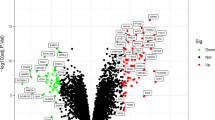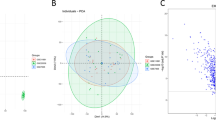Abstract
Objective
To understand the association between chronic inflammation, cellular senescence, and immunological infiltration in endometriosis.
Methods
Datasets from GEO comprising 108 endometriosis and 97 healthy human samples and the human endometrial stromal cell. Differentially expressed genes were identified using Limma and WGCNA. Inflammatory response-related subtypes were constructed using consensus clustering analysis. The CIBERSORT algorithm and correlation analyses assessed immune cell infiltration. LASSO, SVM-RFE, and RF identified diagnostic genes. Functional enrichment analysis and multifactor regulatory networks established functional effects. Nomograms, internal and external validations, and in vitro experiments validated the diagnostic genes.
Results
Inflammatory response subtypes were highly correlated with the immune activities of B and NK cells. Sixteen genes were associated with inflammatory response and cellular senescence and six diagnostic genes (NLK, RAD51, TIMELESS, TBX3, MET, and BTG3) were identified. The six diagnostic gene models had an area under the curve of 0.828 and their expression was significantly downregulated in endometriosis samples. Low expression of NLK and BTG3 promoted the proliferation, migration, and invasion of endometriotic cells.
Conclusions
Inflammatory response subtypes were successfully constructed for endometriosis. Six diagnostic genes related to inflammatory response and cellular senescence were identified and validated. Our study provides novel insights for inflammatory response in endometriosis and markers for endometriosis diagnosis and treatment.









Similar content being viewed by others
Data availability
Data will be made available on request.
References
Allaire C, Bedaiwy MA, Yong PJ. Diagnosis and management of endometriosis. CMAJ. 2023;195:E363–71.
de Ziegler D, Borghese B, Chapron C. Endometriosis and infertility: pathophysiology and management. Lancet. 2010;376:730–8.
Horne AW, Missmer SA. Pathophysiology, diagnosis, and management of endometriosis. BMJ. 2022;379: e070750.
Taylor HS, Kotlyar AM, Flores VA. Endometriosis is a chronic systemic disease: clinical challenges and novel innovations. Lancet. 2021;397:839–52.
Vercellini P, Vigano P, Somigliana E, Fedele L. Endometriosis: pathogenesis and treatment. Nat Rev Endocrinol. 2014;10:261–75.
Saunders PTK, Horne AW. Endometriosis: Etiology, pathobiology, and therapeutic prospects. Cell. 2021;184:2807–24.
Retrograde menstruation. Lancet. 1983;2:25–6.
Symons LK, Miller JE, Kay VR, Marks RM, Liblik K, Koti M, et al. The immunopathophysiology of endometriosis. Trends Mol Med. 2018;24:748–62.
Zhang T, De Carolis C, Man GCW, Wang CC. The link between immunity, autoimmunity and endometriosis: a literature update. Autoimmun Rev. 2018;17:945–55.
Montagna P, Capellino S, Villaggio B, Remorgida V, Ragni N, Cutolo M, et al. Peritoneal fluid macrophages in endometriosis: correlation between the expression of estrogen receptors and inflammation. Fertil Steril. 2008;90:156–64.
Lousse JC, Van Langendonckt A, Gonzalez-Ramos R, Defrere S, Renkin E, Donnez J. Increased activation of nuclear factor-kappa B (NF-kappaB) in isolated peritoneal macrophages of patients with endometriosis. Fertil Steril. 2008;90:217–20.
Campisi J, Kapahi P, Lithgow GJ, Melov S, Newman JC, Verdin E. From discoveries in ageing research to therapeutics for healthy ageing. Nature. 2019;571:183–92.
Gorgoulis V, Adams PD, Alimonti A, Bennett DC, Bischof O, Bishop C, et al. Cellular senescence: defining a path forward. Cell. 2019;179:813–27.
van Deursen JM. The role of senescent cells in ageing. Nature. 2014;509:439–46.
Zhu X, Chen Z, Shen W, Huang G, Sedivy JM, Wang H, et al. Inflammation, epigenetics, and metabolism converge to cell senescence and ageing: the regulation and intervention. Signal Transduct Target Ther. 2021;6:245.
Li X, Li C, Zhang W, Wang Y, Qian P, Huang H. Inflammation and aging: signaling pathways and intervention therapies. Signal Transduct Target Ther. 2023;8:239.
Sayed N, Huang Y, Nguyen K, Krejciova-Rajaniemi Z, Grawe AP, Gao T, et al. An inflammatory aging clock (iAge) based on deep learning tracks multimorbidity, immunosenescence, frailty and cardiovascular aging. Nat Aging. 2021;1:598–615.
Munoz-Espin D, Serrano M. Cellular senescence: from physiology to pathology. Nat Rev Mol Cell Biol. 2014;15:482–96.
Yang P, Lu J, Zhang P, Zhang S. Comprehensive analysis of prognosis and immune landscapes based on lipid-metabolism- and ferroptosis-associated signature in uterine corpus endometrial carcinoma. Diagnostics (Basel). 2023;13(5):870.
Yang P, Zhang P, Zhang S. RNA-binding protein MEX3A interacting with DVL3 stabilizes Wnt/beta-catenin signaling in endometrial carcinoma. Int J Mol Sci. 2022;24(1):592.
Watanabe S, Alexander M, Misharin AV, Budinger GRS. The role of macrophages in the resolution of inflammation. J Clin Invest. 2019;129:2619–28.
Szukiewicz D. Epigenetic regulation and T-cell responses in endometriosis - something other than autoimmunity. Front Immunol. 2022;13: 943839.
Catalana R, Kirkpatrick DR. Verbal approval and anxiety in serial-verbal learning. Psychol Rep. 1968;23:1251–4.
Ascher DP, Shoupe BA, Robb M, Maybee DA, Fischer GW. Comparison of standard and quantitative blood cultures in the evaluation of children with suspected central venous line sepsis. Diagn Microbiol Infect Dis. 1992;15:499–503.
Lv SJ, Sun JN, Gan L, Sun J. Identification of molecular subtypes and immune infiltration in endometriosis: a novel bioinformatics analysis and In vitro validation. Front Immunol. 2023;14:1130738.
Jiang H, Zhang X, Wu Y, Zhang B, Wei J, Li J, et al. Bioinformatics identification and validation of biomarkers and infiltrating immune cells in endometriosis. Front Immunol. 2022;13: 944683.
Gan L, Sun J, Sun J. Bioinformatical analysis identifies PDLIM3 as a potential biomarker associated with immune infiltration in patients with endometriosis. PeerJ. 2022;10: e13218.
Wilson TJ, Hertzog PJ, Angus D, Munnery L, Wood EC, Kola I. Decreased natural killer cell activity in endometriosis patients: relationship to disease pathogenesis. Fertil Steril. 1994;62:1086–8.
Sikora J, Mielczarek-Palacz A, Kondera-Anasz Z. Role of natural killer cell activity in the pathogenesis of endometriosis. Curr Med Chem. 2011;18:200–8.
Kanzaki H, Wang HS, Kariya M, Mori T. Suppression of natural killer cell activity by sera from patients with endometriosis. Am J Obstet Gynecol. 1992;167:257–61.
Riccio LGC, Baracat EC, Chapron C, Batteux F, Abrao MS. The role of the B lymphocytes in endometriosis: a systematic review. J Reprod Immunol. 2017;123:29–34.
Cargnello M. Roux PP (2011) Activation and function of the MAPKs and their substrates, the MAPK-activated protein kinases. Microbiol Mol Biol Rev. 2011;75:50–83.
Zhang Y, Peng C, Wu G, Wang Y, Liu R, Yang S, et al. Expression of NLK and its potential effect in ovarian cancer chemotherapy. Int J Gynecol Cancer. 2011;21:1380–7.
Wang X, Veeraraghavan J, Liu CC, Cao X, Qin L, Kim JA, et al. Therapeutic targeting of nemo-like kinase in primary and acquired endocrine-resistant breast cancer. Clin Cancer Res. 2021;27:2648–62.
Shi C, Xu L, Tang Z, Zhang W, Wei Y, Ni J, et al. Knockdown of nemo-like kinase promotes metastasis in non-small-cell lung cancer. Oncol Rep. 2019;42:1090–100.
Bhowmick R, Lerdrup M, Gadi SA, Rossetti GG, Singh MI, Liu Y, et al. RAD51 protects human cells from transcription-replication conflicts. Mol Cell. 2022;82(3366–3381): e9.
Choi YS, Park JH, Lee JH, Yoon JK, Yun BH, Park JH, et al. Association between impairment of DNA double strand break repair and decreased ovarian reserve in patients with endometriosis. Front Endocrinol (Lausanne). 2018;9:772.
Barrio-Alonso E, Lituma PJ, Notaras MJ, Albero R, Bouchekioua Y, Wayland N, et al. Circadian protein TIMELESS regulates synaptic function and memory by modulating cAMP signaling. Cell Rep. 2023;42: 112375.
Cao M, Wang Y, Xiao Y, Zheng D, Zhi C, Xia X, et al. Activation of the clock gene TIMELESS by H3k27 acetylation promotes colorectal cancer tumorigenesis by binding to Myosin-9. J Exp Clin Cancer Res. 2021;40:162.
Zhang S, Huang P, Dai H, Li Q, Hu L, Peng J, et al. TIMELESS regulates sphingolipid metabolism and tumor cell growth through Sp1/ACER2/S1P axis in ER-positive breast cancer. Cell Death Dis. 2020;11:892.
Wei S, Wu X, Chen M, Xiang Z, Li X, Zhang J, et al. Exosomal-miR-129-2-3p derived from Fusobacterium nucleatum-infected intestinal epithelial cells promotes experimental colitis through regulating TIMELESS-mediated cellular senescence pathway. Gut Microbes. 2023;15:2240035.
Shen X, Li M, Mao Z, Yu W. Loss of circadian protein TIMELESS accelerates the progression of cellular senescence. Biochem Biophys Res Commun. 2018;503:2784–91.
Xing X, Gu F, Hua L, Cui X, Li D, Wu Z, et al. TIMELESS promotes tumor progression by enhancing macrophages recruitment in ovarian cancer. Front Oncol. 2021;11: 732058.
Morales-Santana S, Morell S, Leon J, Carazo-Gallego A, Jimenez-Lopez JC, Morell M. An overview of the polymorphisms of circadian genes associated with endocrine cancer. Front Endocrinol (Lausanne). 2019;10:104.
Wang Z, He S, Xin L, Zhou Y, Zhao L, Wang F. HMGB1-mediated transcriptional activation of circadian gene TIMELESS contributes to endometrial cancer progression through Wnt-beta-catenin pathway. Cell Signal. 2024;116: 111045.
Khan SF, Damerell V, Omar R, Du Toit M, Khan M, Maranyane HM, et al. The roles and regulation of TBX3 in development and disease. Gene. 2020;726: 144223.
Liang B, Zhou Y, Qian M, Xu M, Wang J, Zhang Y, et al. TBX3 functions as a tumor suppressor downstream of activated CTNNB1 mutants during hepatocarcinogenesis. J Hepatol. 2021;75:120–31.
Yotova I, Hsu E, Do C, Gaba A, Sczabolcs M, Dekan S, et al. Epigenetic alterations affecting transcription factors and signaling pathways in stromal cells of endometriosis. PLoS ONE. 2017;12: e0170859.
Guo R, Luo J, Chang J, Rekhtman N, Arcila M, Drilon A. MET-dependent solid tumours: molecular diagnosis and targeted therapy. Nat Rev Clin Oncol. 2020;17:569–87.
Khan KN, Masuzaki H, Fujishita A, Kitajima M, Sekine I, Matsuyama T, et al. Estrogen and progesterone receptor expression in macrophages and regulation of hepatocyte growth factor by ovarian steroids in women with endometriosis. Hum Reprod. 2005;20:2004–13.
Yoshida S, Harada T, Mitsunari M, Iwabe T, Sakamoto Y, Tsukihara S, et al. Hepatocyte growth factor/Met system promotes endometrial and endometriotic stromal cell invasion via autocrine and paracrine pathways. J Clin Endocrinol Metab. 2004;89:823–32.
Yamashita Y, Akatsuka S, Shinjo K, Yatabe Y, Kobayashi H, Seko H, et al. Met is the most frequently amplified gene in endometriosis-associated ovarian clear cell adenocarcinoma and correlates with worsened prognosis. PLoS ONE. 2013;8: e57724.
Cheng YC, Chiang HY, Cheng SJ, Chang HW, Li YJ, Shieh SY. Loss of the tumor suppressor BTG3 drives a pro-angiogenic tumor microenvironment through HIF-1 activation. Cell Death Dis. 2020;11:1046.
Ren T, Hou J, Liu C, Shan F, Xiong X, Qin A, et al. The long non-coding RNA HOTAIRM1 suppresses cell progression via sponging endogenous miR-17-5p/ B-cell translocation gene 3 (BTG3) axis in 5-fluorouracil resistant colorectal cancer cells. Biomed Pharmacother. 2019;117: 109171.
Geng R, Huang X, Li L, Guo X, Wang Q, Zheng Y, et al. Gene expression analysis in endometriosis: Immunopathology insights, transcription factors and therapeutic targets. Front Immunol. 2022;13:1037504.
Bjorkman S, Taylor HS. MicroRNAs in endometriosis: biological function and emerging biomarker candidatesdagger. Biol Reprod. 2019;100:1135–46.
Funding
This work was supported by grants from the Science and Technology Commission of Shanghai Municipality (22Y11906100) to Jing Sun and Shanghai Outstanding Academic Leaders Plan to Jing Sun (Year 2019).
Author information
Authors and Affiliations
Contributions
Pusheng Yang Conceptualization, Methodology, Software, Visualization, Validation and Writing – original draft. Yaxin Miao, Visualization, Validation. Tao Wang, Validation. Jing Sun: Conceptualization, Supervision, Writing – review & editing. All authors contributed to manuscript revision, read, and approved the submitted version.
Corresponding author
Ethics declarations
Conflict of interest
The authors declare no competing interests.
Additional information
Responsible Editor: John Di Battista.
Publisher's Note
Springer Nature remains neutral with regard to jurisdictional claims in published maps and institutional affiliations.
Supplementary Information
Below is the link to the electronic supplementary material.
Rights and permissions
Springer Nature or its licensor (e.g. a society or other partner) holds exclusive rights to this article under a publishing agreement with the author(s) or other rightsholder(s); author self-archiving of the accepted manuscript version of this article is solely governed by the terms of such publishing agreement and applicable law.
About this article
Cite this article
Yang, P., Miao, Y., Wang, T. et al. Identification of diagnostic markers related to inflammatory response and cellular senescence in endometriosis using machine learning and in vitro experiment. Inflamm. Res. (2024). https://doi.org/10.1007/s00011-024-01886-5
Received:
Revised:
Accepted:
Published:
DOI: https://doi.org/10.1007/s00011-024-01886-5




